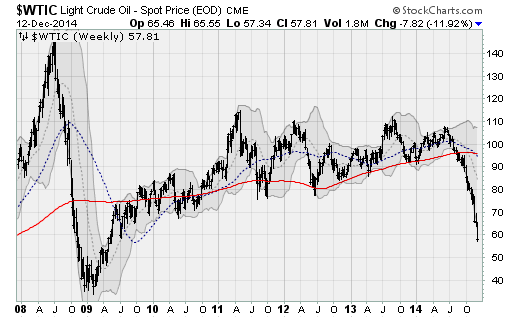Oil's collapse sends stocks skidding
It just keeps getting worse.
On Friday, the Dow Jones industrials lost more than 315 points, a 1.8 percent decline, to cap a weekly loss of 3.8 percent -- the deepest drop since November 2011. U.S. benchmark crude scythed below $58 a barrel for the first time since May 2009 for a weekly loss of nearly 12 percent in the midst of a tumble whose severity and magnitude matched what happened during the 2008 financial crisis.
Technically, the major averages dropped to test support near their 50-day moving averages. A break of these levels would put the 200-day averages in play, which would be worth another 450 points, or 2.6 percent, on the Dow.
The Standard & Poor's 500 and Nasdaq fared nearly as poorly as the Dow on Friday. The S&P fell 33 points, or 1.6 percent, closing at 2,002.33 and giving the broad market benchmark a 3.5 percent fall for the week, its biggest drop since May 2012. Nasdaq dropped 54.57 points, or 1.2 percent, finishing at 4,653.60.
Investors were ill prepared. Just a week ago, spirits were high heading into the weekend after the Dow flirted with the 18,000 level for the first time ever after November's blow-out jobs report. Moreover, December is historically the best performing month for large-cap stocks. And the 50 percent drop in gas prices from their summertime highs was padding American's pocketbooks heading into the critical phase of the holiday shopping season.
But just seven days later, the darkness has come in.
The core of the problem is that, as I explored in a recent column, people are realizing that while the precipitous decline in oil prices is great for consumers, it has negative consequences for the overall economy as well as financial markets. Lower crude oil will put pressure on indebted, high-cost U.S. shale oil producers, which will be forced to cut back on production, investment, and hiring before energy prices can stabilize.
And that will likely result in bankruptcies and debt restructurings, which will hit the high-yield corporate bond market. Energy companies have been voracious issuers of junk bonds in recent years and now account for about 16 percent of the total U.S. junk bond market. Deutsche Bank in November warned that a drop in crude oil to $60 a barrel would likely result in about a third of this debt suffering default -- enough to send shockwaves throughout the fixed-income market.
According to Lipper data, investors pulled $1.9 billion from junk bonds this week, the most since October. As a result, the Barclays High Yield Bond SPDR (JNK) dropped to levels not seen since October 2013.
Other moving parts are involved as well, from disappointing economic data out of Japan, political drama in Greece, budget machinations in Washington and more.
But right here, right now, crude oil's fall matters most.
Relief could come next week if the Federal Reserve's last policy statement of the year is dovish, talking up the downside risks to inflation of the halving of energy prices in just six months. By pushing back its estimates of the timing and pace of interest rate hikes, the Fed would more closely align itself with the much more cautious expectations already baked into the Treasury bond market. Interest rates have fallen to levels not seen since June 2013, with the 10-year yield back down to 2.1 percent.
That could help oil recover by weakening the U.S. dollar.
Yet unless oil gets back up to $80 a barrel soon, which is where Barclays Capital pegs the industry's breakeven price, the energy sector will remain in trouble. We need to see a meaningful cut in supply (either from OPEC or from U.S. shale) or an increase in demand (from a reacceleration of economies in Asia and Europe).
And with OPEC officials confirming this week that they're in no hurry to cut production -- with no emergency meeting planned until the first quarter of 2015 -- the best hope is a rebound in demand. Unfortunately, the International Energy Agency just cut its 2015 oil demand growth forecast by 230,000 barrels per day to 900,000. That's the fourth lowering of the forecast over the past five months.
Maybe Americans, as the lone bright spot of the global economy, need to do a little extra driving to make up the difference.



